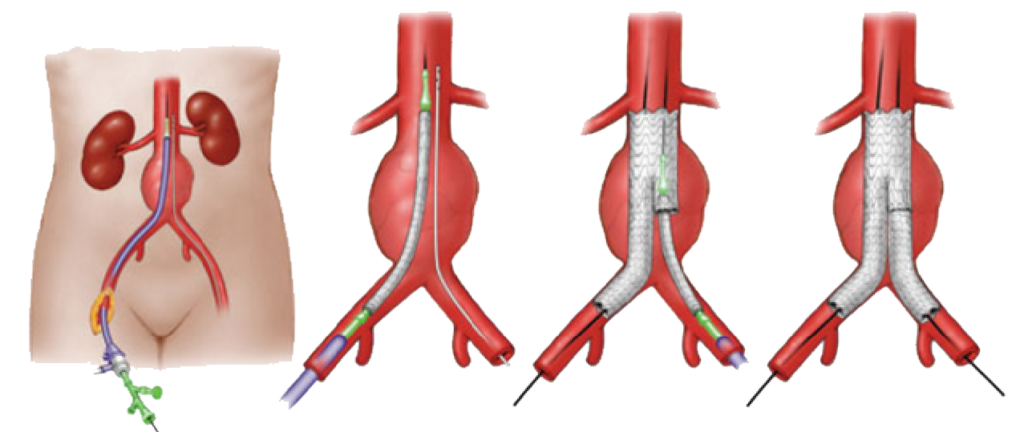Symptoms, Causes, and Treatments
Introduction
An abdominal aortic aneurysm (AAA) is a serious condition that affects the aorta, the largest blood vessel in the human body. If left untreated, an AAA can rupture, causing severe internal bleeding and even death. In this article, we will discuss the symptoms, causes, and treatments of AAA.
What is an Abdominal Aortic Aneurysm?
An abdominal aortic aneurysm occurs when the wall of the aorta weakens and bulges outwards. It usually develops slowly over many years and often goes unnoticed until it becomes large or ruptures.
Causes of Abdominal Aortic Aneurysm
There are several risk factors that can increase the likelihood of developing an AAA. These include:
- Age: AAA is more common in people over the age of 60.
- Gender: Men are more likely to develop AAA than women.
- Smoking: Smokers are at a much higher risk of developing AAA than non-smokers.
- High blood pressure: People with high blood pressure are more likely to develop AAA.
- Family history: If someone in your family has had an AAA, you are more likely to develop one.
Symptoms of Abdominal Aortic Aneurysm
In many cases, AAA does not cause any symptoms. However, some people may experience:
- A pulsating sensation in the abdomen
- Persistent pain in the abdomen or lower back
- Back pain that is severe, sudden, and persistent
- Nausea and vomiting
- Rapid heartbeat
Diagnosis of Abdominal Aortic Aneurysm
AAA is often diagnosed during a routine physical examination, where a doctor may feel a pulsating mass in the abdomen. If an AAA is suspected, imaging tests such as an ultrasound, CT scan, or MRI may be performed to confirm the diagnosis and determine the size and location of the aneurysm.
Treatment of Abdominal Aortic Aneurysm
The treatment of AAA depends on the size and location of the aneurysm, as well as the overall health of the patient. Small aneurysms may simply be monitored with regular imaging tests, while larger aneurysms may require surgical intervention.
- Endovascular Aneurysm Repair (EVAR): This minimally invasive procedure involves inserting a stent graft into the aneurysm to reinforce the weakened section of the aorta.
- Open Surgery: This is a more invasive procedure where the aneurysm is repaired through an incision in the abdomen or chest.
Prevention of Abdominal Aortic Aneurysm
There are several steps you can take to reduce your risk of developing AAA:
- Quit smoking: This is the most important step you can take to reduce your risk of developing AAA.
- Maintain a healthy weight: Obesity can increase your risk of developing AAA.
- Exercise regularly: Regular exercise can help maintain good blood pressure and reduce your risk of developing AAA.
- Manage your blood pressure: High blood pressure is a risk factor for AAA, so it is important to keep it under control.
Conclusion
An abdominal aortic aneurysm is a serious condition that can be life-threatening if left untreated. Knowing the symptoms and risk factors can help you identify an AAA early and seek treatment before it becomes a major health concern. If you suspect you may have an AAA, speak to your doctor immediately.
FAQs
Can abdominal aortic aneurysm be prevented?
While the exact cause of AAA is unknown, adopting a healthy lifestyle, managing any underlying health conditions, and avoiding smoking can reduce the risk of developing an AAA.
Can an AAA be treated without surgery?
In some cases, small AAAs can be monitored with regular imaging tests without requiring surgery. However, larger AAAs may require surgical intervention to prevent rupture and potentially life-threatening complications.
How is an abdominal aortic aneurysm diagnosed?
An AAA is often diagnosed during a routine physical examination, where a doctor may feel a pulsating mass in the abdomen. If an AAA is suspected, imaging tests such as an ultrasound, CT scan, or MRI may be performed to confirm the diagnosis and determine the size and location of the aneurysm.
Who is at risk of developing an abdominal aortic aneurysm?
AAA is more common in people over the age of 60, men, smokers, and those with a family history of AAA or high blood pressure. Other risk factors include obesity, atherosclerosis, and certain genetic disorders.
What are the potential complications of an untreated abdominal aortic aneurysm?
If left untreated, an AAA can rupture, causing severe internal bleeding and potentially fatal complications. Early diagnosis and treatment are crucial to prevent these complications and ensure the best possible outcome for the patient.
DISCLAIMER:
This information is not presented by a medical practitioner and is for educational and informational purposes only. The content is not intended to be a substitute for professional medical advice, diagnosis, or treatment. Always seek the advice of your physician or other qualified healthcare providers with any questions you may have regarding a medical condition. Never disregard professional medical advice or delay in seeking it because of something you have read.
Since natural and/or dietary supplements are not FDA-approved they must be accompanied by a two-part disclaimer on the product label: that the statement has not been evaluated by FDA and that the product is not intended to “diagnose, treat, cure or prevent any disease.”





